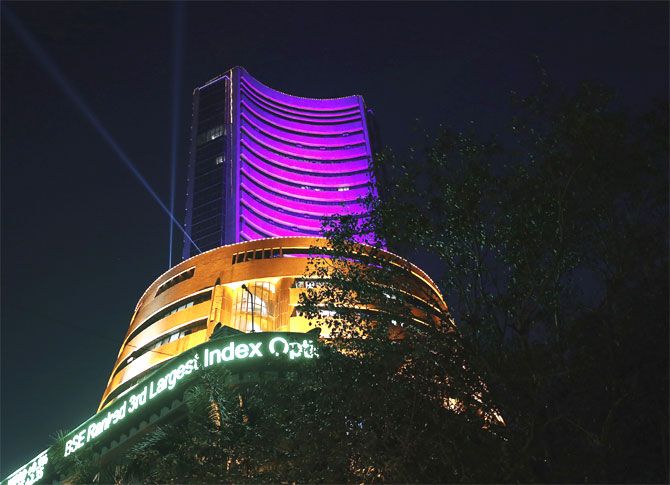The passage of two crucial Bills will boost sentiment but markets could slide again owing to conditions in Europe and the US, notes Devangshu Datta.
 The Budget session saw a limited win for the Bharatiya Janata Party (BJP). The Rajya Sabha (where the BJP is in a minority) passed two key Bills that should contribute to mining reforms.
The Budget session saw a limited win for the Bharatiya Janata Party (BJP). The Rajya Sabha (where the BJP is in a minority) passed two key Bills that should contribute to mining reforms.
The Coal Mines (Special Provisions) Act, 2015, legitimises e-auctions of captive coal blocks, although that has run into controversy with charges of cartelisation.
The Mineral Development and Regulation Act 2015 also passed and that should enable change across the broader mining space. The land acquisition ordinance and the insurance ordinance did not pass.
While the passage of those two Bills will boost sentiments, the massive retrospective tax demands on Cairn India and Cairn Energy are a dampener, contradicting Arun Jaitley's assurances in July 2014 about not making retrospective demands.
Apart from this, the new anti-hawala black money Bill, or the Undisclosed Foreign Income and Assets (Imposition of New Tax) Bill to give it the proper name, contains draconian provisions, which may also have a negative impact on sentiment.
Meanwhile, the US Federal Reserve publicly lost patience and threatened to start displaying signs of active impatience in June.
That is, the American central bank removed a pledge to be "patient" after the meeting of the Federal Open Market Committee that ended on March 18. If the strong US recovery continues, the Fed may raise US policy interest rates at its mid-year policy meeting in June.
The next scheduled meeting of the FOMC in late-April is very likely to be marked by market volatility as traders await more clarification.
A rate hike is not guaranteed. Gross domestic product (GDP) growth and job creation is strong. But growth and core inflation forecasts were downgraded, and housing starts numbers are weak.
Retail sales were negative in February for the third successive month. Inflation is also below the Fed's target. The FOMC cut its estimates for the policy rate by end-2015. This could mean tightening won't occur, in June at least.
Fed Chairperson, Janet Yellen, also admitted to concern about the strength of the US dollar, which hit new 12-year highs as the European Central Bank (ECB) embarked on its massive euro trillion bond-buying programme. The euro may be plummeting towards 1:1 parity versus the dollar. In fact, Goldman Sachs has projected that the euro will slide to $0.80 by 2017.
Most European equity and bond markets rallied through the launch of the ECB's quantitative expansion. European equities have seen $42 billion of inflows since January . There are fears, however, that Greece could spoil the party.
The other issue is strange. The ECB bought bonds worth euro 10 billion in the first three days and this pushed many yields into negative territory.
The Scandinavian central banks and the Swiss have also set negative rates. What happens if large swathes of west European debt go negative yield?
Meanwhile, in China, the People's Bank of China has opened the money supply tap, encouraging credit disbursals in volumes not seen for the last six years.
This is part of a stimulus programme to revive an economy where the GDP growth rate is slowing to 25-year lows. Sundry local governments across China are also trying to swap municipal debt into lower interest instruments.
China's housing market is under pressure with real estate prices declining. Realty developer, Kaisa has technically defaulted on overseas debt of $2.5 billion, which it is now trying to desperately restructure. If it's unsuccessful, there could be very nasty knock-on repercussions.
The Indian markets spiralled into correction mode. There was an initial bounce after the FOMC meet. But that was unsustainable. The Nifty has lost 6 per cent since it hit record highs post-Budget. FIIs remain net buyers. But domestic investors have sold through March.
The rupee did rally against the dollar through the past five sessions. There could be renewed pressure on dollar-rupee next week as oil-marketing public sector undertakings source end-of-month crude.
Meanwhile, Jayant Sinha released specific estimates of some disinvestments. The government hopes to raise Rs 22,574 crore from selling stakes in ONGC, (Rs 13,217 crore for 5 per cent), NMDC (Rs 5,038 crore for 10 per cent), BHEL (Rs 3,129 crore, 5 per cent) and Nalco (Rs 1,190 crore, 10 per cent). The disinvestment revenue target is Rs 69,500 crore for 2015-16.
If the market continues to slide, those estimates will need to be reviewed down. The last big bottom for the Nifty was at 7,960 (December 17, 2014).
The 200-day moving average (seen as a good support for a bull market) is near 8,137. There could be cause for worry if the market drops to those levels again. Or, of course, long-term investors might view that as a buying opportunity.










